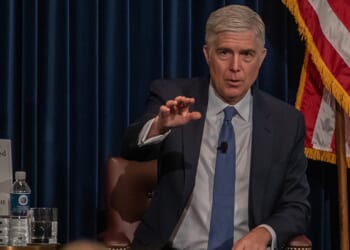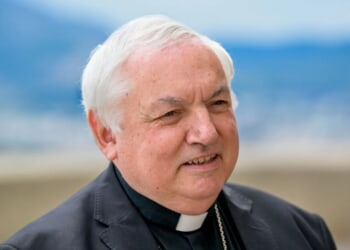The recent EU-Central Asia Summit demonstrated how Brussels is paying more attention to the region than Washington.
Central Asia is attracting growing attention from global powers because of its resources and strategic location in the heart of the Eurasian continent. It is no surprise that the EU is taking a proactive position in relationship with Central Asia. On April 4, 2025, the first-ever summit between leaders of the EU and the five countries of Central Asia (Kazakhstan, Kyrgyzstan, Tajikistan, Turkmenistan, and Uzbekistan) took place in Samarkand, Uzbekistan.
President Shavkat Mirziyoyev of Uzbekistan hosted the summit. António Costa, President of the European Council, and Ursula von der Leyen, President of the European Commission, represented the EU. The summit upgraded relations between the European Union and Central Asia to a strategic partnership level and outlined priority directions of the cooperation, with the EU committing significant resources for projects improving connectivity between Central Asia and Europe, as well as for the development of the resources of critical minerals, important for European and global economy.
The gathering covered a range of security, political, and economic issues and opened new opportunities for the EU and countries of Central Asia to deepen partnerships on both the multilateral and bilateral levels. The European interest is multifaceted, but economic interest stands out. Central Asia is important for European energy security. Central Asia is also rich in minerals critical to energy transition and electric vehicles. The region is equally well positioned to be a supplier of critical minerals to the transatlantic markets as it is in oil and gas supply.
The leaders at the Summit supported enhanced cooperation on critical raw materials and endorsed the EU-Central Asia declaration of intent on critical raw materials, which envisages EU commitment of €2.5 billion for critical raw material projects. The declaration on critical raw materials is a part of the €12 billion Global Gateway Investment Package. The EU has committed to Central Asia to concentrate on four priorities, including the Trans-Caspian Transport Corridor, clean energy, and digital connectivity.
It is important to mention that Central Asian economies are growing fast. The GDP annual growth rates in the region largely exceed the global average. This means that the purchasing power of citizens of Central Asian states is also growing, making it an attractive market for European exports. The EU is already the region’s second-largest trading partner (contributing to 22.6 percent of combined foreign trade in 2023) and the largest investor. Over 40 percent of the region’s foreign direct investment flows from European finance. Growing economies, trade, and investments mean greater inbound and outbound traffic between Central Asia and Europe.
For trade and investments to succeed, it is essential to improve transportation, digital access, and connectivity between Central Asia and Europe. The joint declaration of the EU-Central Asia Summit states that “The EU and Central Asia reaffirmed their commitment to strengthening sustainable transport connectivity as a driver of economic growth and regional integration.”
The summit declaration builds on a 2023 EU Study that investigated sustainable transport connections between Europe and Central Asia and on the Global Gateway Investors Forum for EU-Central Asia Transport Connectivity that took place in January 2024. The forum had decided to raise €10 billion from the international community in support of sustainable transport connectivity in Central Asia.
The Global Gateway Investment package is also meant to help Central Asia become a clean energy hub that generates enough for its economy but also for export. There is a potential to turn part of its energy into clean hydrogen using wind, solar, hydro, and geothermal energy resources. The Summit reiterated support for clean energy development for domestic and export needs.
The parties additionally agreed to support the Coordination Platform for the Trans-Caspian Transport Corridor and critical infrastructure projects along the Central Asia-Caucasus-Europe (CACE) corridor, also known as the Middle Corridor, ensuring mutual market access and long-term cooperation. The objective is to establish a modern and efficient transportation route linking Europe and Asia, which delivers goods in fifteen days or less. If this objective is reached, the region will attract significant attention from traders for commodities, as well as finished goods.
In order to attract private investments and promote the potential of the economic corridor, the summit participants agreed to organize the Trans Caspian Transport Corridor (TCTC) Investors’ Forum and the EU-Central Asia Economic Forum in Uzbekistan later this year.
The countries of Central Asia and the South Caucasus invested significant resources in their infrastructure development. It is critical now for the EU and European financial institutions—like the European Bank for Reconstruction and Development (EBRD) and the European Investment Bank (EIB)—to focus on further developments and investments in projects that could eliminate existing bottlenecks and facilitate greater connectivity.
More investments throughout the CACE corridor, including infrastructure in the Caspian and Black Seas, will allow for the meeting of rising needs and facilitate greater trade between the two regions. The EU also needs to consider the integration of this corridor with projects like the Three Seas Initiative in order to achieve the benefits of synergy. It is also important that there is greater coordination with the parallel project with significant European interest, the India-Middle East-Europe Economic Corridor (IMEC).
It is significant that the joint declaration of the EU-Central Asia Summit also states that parties agreed on the importance of peace and stability in the South Caucasus as a prerequisite to the successful implementation of these projects, which elevates the significance of the South Caucasus for the European strategic calculations.
The elevation of the EU-Central Asia partnership to the strategic level is significant. It will concern both Russia and China, who consider Central Asia to be an area of their vital interests. However, with the absence of a security dimension in this partnership, the level of concern and reaction will be limited.
Another active actor with interests in Central Asia, Turkiye, should welcome growing European investments in Central Asia-The South Caucasus-Europe connectivity because it benefits both directly and indirectly.
The bigger question is whether the United States, in the current geopolitical environment, is interested in having a proactive, complementary role and coordinating its interests and activities in Central with the EU. Or will Washington go alone and focus on its own diplomatic, political, and economic tools to advance its interests in Central Asia?
If the United States chooses the latter path, it has to consider greater diplomatic focus and allocate more financial resources, which will match the investments of other actors. In the era of dominating pragmatism, this will be an important factor in the calculations of Central Asian states, along with strategic considerations.
The EIB is opening its permanent office in Uzbekistan, and the EBRD has a long and successful presence and profitable investments in the region. The United States needs to match the funding opportunities of Europeans and other actors in order to get attention. There is a great opportunity for the upgraded U.S. Development Finance Corporation to make Central Asia one of its priority areas, thus increasing America’s impact on the region.
Nevertheless, at this stage, it looks like the EU is well ahead of the United States in terms of the commitments of public and private investments in the development of Central Asia’s connectivity to the world markets.
About the Author: Mamuka Tsereteli
Dr. Mamuka Tsereteli is a Senior Fellow for Eurasia at the American Foreign Policy Council and a Senior Fellow with the Central Asia-Caucasus Institute (CACI). He has more than thirty years of experience in academia, diplomacy, and business development, focusing on economic security, business, and energy developments in the Black Sea-Caspian region. Previously, he served as a Research Director for CACI and professor at Johns Hopkins University School of Advanced International Studies (SAIS). He also directed the Center for Black Sea-Caspian Studies at the School of International Service (SIS) at American University (2009-2013) and served as an assistant professor at SIS (2007-2011). Dr. Tsereteli is also a Co-Founder of the American University Kyiv, a newly created university in Ukraine, powered by Arizona State University.
Image: Miss.Cabul / Shutterstock.com.
















